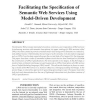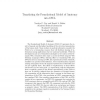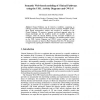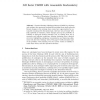252 search results - page 4 / 51 » Using OWL to model biological knowledge |
JWSR
2006
13 years 7 months ago
2006
The Semantic Web promises automated invocation, discovery, and composition of Web services by enhancing services with semantic descriptions. An upper ontology for Web services cal...
WS
2008
ACM
13 years 7 months ago
2008
ACM
The Foundational Model of Anatomy (FMA) [7] represents the result of manual and disciplined modeling of the structural organization of the human body. Many workers in medical info...
AIME
2009
Springer
13 years 8 months ago
2009
Springer
: Clinical Pathways can be viewed as workflows, comprising an ordering of activities with associated execution constraints. Workflow models allow formal representation, analysis an...
IADIS
2003
13 years 8 months ago
2003
Ontologies in a web setting, particularly those used in a group context (such as a virtual community), need to be flexible and open to changes that reflect the evolution of knowle...
OWLED
2008
13 years 9 months ago
2008
Chemical Entities of Biological Interest (ChEBI) is a database and ontology that represents biochemical knowledge about small molecules. Recent changes to the ontology have created...




